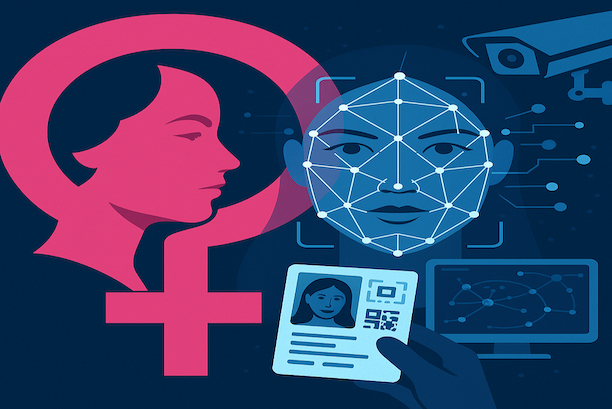| « CYBER-ELDERS OF ZION: TECHNO-ZIONISM AND THE GLOBAL ALGORITHMIC COVENANT | Blue Zones and Longevity – Lessons from the World’s Healthiest Centenarians » |
Why the Bio-Surveillance State Needs Feminism to Survive
By Chris Spencer
I. The Pink Face of the Machine
Let us be unequivocal: this is not your grandmother’s feminism. This is not the feminism of burning corsets, union hall speeches, or back-alley pamphleteering. It is not the grit-flecked feminism of hunger marches or the impassioned cries of textile workers demanding bread and roses. This is a feminism reconstituted in glass boardrooms, programmed into software updates, disseminated via Instagram reels, and keynote-slid across World Economic Forum panels. It is a soft mask juxtaposed upon Facial Recognition Panopticonism.
What does this “feminism” empower, if not women?
It empowers databases. It empowers biometric grids. It empowers algorithmic sentinels in the sky. It empowers the Surveillance Mind-Control Tech Titans State.
Look no further than the modern marketing of biometric ID systems to women in the Global South. Development agencies—USAID, the World Bank, the Bill and Melinda Gates Foundation—now preach the gospel of “gender equity” as a rationale for digitizing identity. Ostensibly, these programs seek to help “undocumented women” in rural communities. On its face, a noble cause. But the solution they offer bypasses every organic, locally-rooted tradition of civic life in favor of hyper-digitized, transnational surveillance apparatuses. Iris scans, blockchain-anchored identity ledgers, QR-coded dependency systems—tethered not merely to vaccination status, but also to carbon consumption, nutritional inputs, menstrual health, and even geospatial movement patterns.
Under the guise of progress, what we get is the codification of the womb. The uterus as a metadata node. The cervix as a biometric access point.
And all of this intrusion is lacquered in the language of liberation. Promotional materials feature smiling brown-skinned women holding up digital ID cards as if they were diplomas from the University of Modernity. Meanwhile, Western feminists—naive, institutionalized, or simply complicit—cheer from afar, celebrating this “empowerment” without interrogating the price: the wholesale outsourcing of bodily sovereignty to cloud servers owned by Microsoft, Amazon Web Services, and Palantir. An Orwellian BIG MOTHER masquerading as “freedom.”
They mistake inclusion for autonomy. But this is not emancipation—it is digitized dependency.
II. From Suffrage to Self-Surveillance
To comprehend this shift, we must trace the ideological metastasis of feminism itself. What originated as a robust counter-force to patriarchy—sometimes radical, sometimes revolutionary—has been gradually retrofitted into a companion ideology for neoliberal technocracy.
Ms. Magazine, midwifed by CIA asset Gloria Steinem, was never merely a publication—it was a psyop in pantyhose, laundering imperial ideology through the rinse cycle of women’s liberation. What began as a glossy Trojan horse now struts as digital priestess, anointing biometric ID cards and vaccine mandates with the perfumed oil of "equity."
Second-wave critiques of domestic labor, reproductive autonomy, and structural inequality were metabolized by capitalism, reshaped into slogans for lean-in corporate feminism. By the time third-wave feminism arrived, with its fractal obsession over identity performance and personal narrative, the movement had already been sliced into data-harvestable demographics.
And now we enter the fourth wave: algorithmic, hypermediated, commodified. #MeToo, #BelieveWomen, and #MyBodyMyChoice began as righteous rallying cries—but quickly became echo chambers of digital self-surveillance. Every trauma now needs a hashtag. Every act of resistance must be captured, filtered, and shared. The personal is no longer just political; it is now product.
What was once feminist praxis has become performative compliance.
In this ecosystem, surveillance is no longer an aberration—it is the norm. The feminist body has ceased to be a battleground; it is now an interface. Feminist discourse has been absorbed into the soft-power arsenal of the bio-surveillance state. Facial recognition tools are trained using feminist facial datasets. Emotion-detecting AI now flags “gendered distress.” Tech conglomerates recruit feminist scholars to serve on “ethics boards” that greenlight predictive policing algorithms.
In short, the surveillance state now speaks fluent feminist.
It speaks of “safe spaces,” of “equity audits,” of “gender-responsive programming.” And like a ventriloquist working a hand-puppet, it uses the face of care to deliver the logic of control.
III. Vaccines, Consent, and the Feminist Paradox
No terrain better exemplified this merger of compassion and coercion than the COVID-19 pandemic.
Suddenly, public health decrees were recast as feminist mandates. Vaccine refusal was no longer merely a personal health decision—it became a betrayal of womanhood, a renunciation of maternal duty. To question the shot was to endanger pregnant women, to jeopardize elderly caregivers, to disrespect nurses and healthcare workers—occupations still coded, in the public psyche, as feminized labor.
Mainstream feminist publications from Ms. Magazine to Jezebel ran op-eds framing vaccine compliance as a feminist imperative. “Care is feminist,” they declared. “Science is feminist.” And thus, dissent became misogyny.
But this argument carried with it a colossal paradox. In the name of defending bodily autonomy, the state imposed unprecedented controls on the body. Digital health passports—eerily reminiscent of China’s social credit scaffolding—became prerequisites for mobility. These were tied directly to biometric IDs and vaccination records. Feminist ideology provided the narrative framework, the moral justification for this techno-medical enclosure.
Consent was redefined. It became algorithmic, conditional, tethered to compliance. A QR code, not a “yes.”
The unvaccinated woman—once the icon of sovereignty—was now cast as a traitor. A Typhoid Mary in Lululemon. Canceled, scorned, and digitally disappeared by the very feminism that once championed her agency.
IV. The Transhumanist Trojan Horse
Beyond public health lies the ultimate frontier: the fusion of biology and circuitry, of hormone and code. Transhumanism—long relegated to the margins of futurist fantasy—has now emerged as the mainstream ideology of the bio-security regime. And once again, feminism is summoned not as a critic, but as a cheerleader.
The rise of non-binary identity, gender fluidity, and transgender visibility—genuine human phenomena worthy of care and understanding—have also been weaponized by the techno-capital elite to normalize the digitization of flesh. Hormone replacement therapy becomes a doorway to synthetic biology. Gender-affirming surgeries pave the way for body modification platforms. Neuroplasticity discourse segues into neural-lace implants. Feminism is used to dissolve biological boundaries, making the human body more legible to code.
Suddenly, it is not radical to question the encroachment of biotech—it is reactionary. The defense of embodied reality becomes hate speech.
And with that, the female body—long the primary site of cultural, religious, and political conflict—becomes a laboratory. A test site. A terrain of profitable manipulation. Menstrual cycles are tracked by predictive AI; ovulation patterns sold to hedge-fund-backed fertility startups. Breast cancer risk is no longer a concern of physicians, but a monetized forecast calculated by a Microsoft algorithm and sold to insurance markets.
The womb becomes a subscription service.
The bio-surveillance state does not demand submission—it demands integration. And feminism, now deracinated from its radical roots, offers itself up as the lingua franca of this transformation.
V. Policing Through Empathy
The final coup of the surveillance regime is not to oppress with brutality but to police through empathy.
The baton is gone. In its place, a biometric wristband flashing “hydration reminder.” The prison cell is replaced with a “wellness pod.” Sterilization campaigns are reframed as “reproductive justice initiatives,” sponsored by BlackRock.
Feminism—especially in its bureaucratized, NGO-ified incarnation—serves as the perfect delivery vehicle. Because it speaks the language of healing. Because it reframes power as “protection,” and control as “compassion.” It’s not a boot stomping on a face—it’s a rainbow-stickered app nudging you to eat fewer calories and take your prescribed hormone injection.
The goal is not to suppress dissent, but to coerce enthusiastic consent. Consent wrapped in hashtags. Consent choreographed through online dance challenges. Consent branded with corporate logos and intersectional slogans. Feminism, co-opted and instrumentalized, becomes the interpretive layer through which state control is filtered, softened, and aestheticized.
Feminism, once the unruly child of dissent, has been abducted by the step-parents of Surveillance Capital and Military Bureaucracy, who now dress it in therapeutic jargon and parade it through TED Talks.
Google funds “empowerment initiatives” while feeding facial datasets to DHS. Lockheed Martin sponsors Women in STEM luncheons even as its drone contracts turn Afghan midwives into collateral damage. The CIA funds gender equity studies in Tehran while contracting with Booz Allen to mine menstrual apps for counterinsurgency cues. Palantir, co-founded by “libertarian” Peter Thiel, scrubs data for ICE deportations while underwriting “diversity in AI” programs. The Gates Foundation speaks of maternal health while pushing biometric ID wallets in Africa. FEMA, HHS, and the WHO drape their edicts in pastel infographics stamped with phrases like “care,” “choice,” and “safety,” (NEGLECT, FORCE AND DANGER) while embedding algorithmic compliance into every social service. This is not feminism—it is counterinsurgency in a pink pantsuit.
This is surveillance with a soft touch. This is techno-fascism with a heart emoji.
The bio-state does not need to wage war on women. It simply needs women to feel seen. To feel heard. To feel included. And in exchange, it will map their bodies, regulate their hormones, assign them behavioral scores, and upload their identities to interoperable cloud platforms owned by the next Peter Thiel or Palantir spinoff.
Feminism Under Watch: The Smothering Care of the Orwellian State
The state arrives not as tyrant, but as caretaker. Not with jackboots, but with wellness surveys, panic buttons, and predictive dashboards. Its voice is soft, clinical, and maternal: “We only want to keep you safe.” Its hands are gloved in regulation, reaching always for more data, more access, more permission—always in the name of care.
And feminism—once a rebel creed forged in the fire of autonomy—has been gently escorted into this velvet prison. Protection has replaced power. Vulnerability has eclipsed volition. The woman is no longer citizen; she is subject. She is at risk, and thus must be watched.
Today’s surveillance state frames its expansion through the mirror of female peril. Trafficking. Domestic violence. Exploitation. Each presented as a righteous cause, each exploited as a policy wedge. It is moral camouflage—the algorithm arrives not with force, but with flowers. Facial recognition is deployed not to suppress dissent, but to rescue women. Biometric ID systems are rolled out not for control, but for inclusion.
But beneath the language of safety lies the language of ownership. The woman is not merely seen—she is scanned, scored, sorted. Her decisions are not respected; they are preempted. Her consent is not obtained; it is presumed.
The state, in short, has reimagined itself as a digital husband—forever watching, correcting, providing, preventing. “You don’t have to worry anymore,” it says. “We’ve got you.” And with that embrace comes enclosure.
Consider the contradiction: the woman is lauded as fully autonomous when choosing to terminate a pregnancy, change gender, or lead a tech company. But she is simultaneously cast as helpless when near a border, a brothel, or a bad decision. Is she sovereign or fragile? Empowered or endangered? She cannot be both.
This contradiction is not accidental. It is the mechanism. Feminism has been weaponized not to liberate women, but to authorize the surveillance of them. “Because women are vulnerable, we must monitor them.” “Because women have agency, they must be allowed to choose surveillance.” The result: a woman may be free to sell her data, her body, her image—so long as she does so within the parameters established by the digital state.
What was once pimping is now platforming. What was once voyeurism is now governance. The same systems used to monitor trafficked victims are used to track schoolchildren, workers, migrants, mothers. The same databases built to “rescue” are repurposed to regulate.
And all of it is draped in feminist colors—equality, safety, choice—used not as shields, but as blindfolds.
No man could have pulled this off. Only the algorithm could. Only the state could. Only “care” could.
This is not liberation. This is logistics. This is the infrastructure of managed womanhood, routed through the cloud, indexed by concern, tagged for review.
Feminism, in the custody of the state, has become its favorite daughter and its most useful excuse.
All under the guise of love.
Why the Bio-Surveillance State Needs Feminism to Survive
1. Feminist Surveillance Studies - Duke University Press - The work fills a gap in feminist scholarship and shows that gender, race, class, and sexuality should be central to any study of surveillance.
2. Feminist Surveillance Studies and the Institutionalization of ... - To conclude, we address how intersex activists find each other and propel their activism—activism that combats the surveiling and regulating ...
3. Introduction - Second, it reconsiders the frame of carceral feminism by unpacking some of the assumptions around “carcerality” and “feminism.” Finally, it ...
4. Feminist Surveillance Studies - Amazon.com - Feminist Surveillance Studies is an overture that conceptualizes surveillance within an aesthetics of domination, a luxurious and galvanizing text to be deeply engaged and widely taught.''―Stephanie Amon, Afterimage.
5. Gender, Surveillance, and Social Control - Torin Monahan,2009 - This article explores the gender dimensions of surveillance systems in several public domains: welfare, healthcare, and transportation.
6. Surveillance is a feminist issue - City Research Online - In part one I will offer a brief introduction to the study of surveillance, including emerging work in feminist surveillance studies, and will then introduce ...
###
© 2025 Chris Spencer




